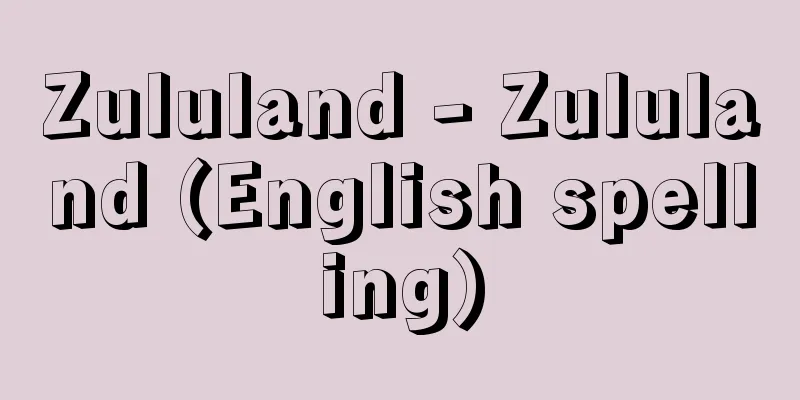Zululand - Zululand (English spelling)

|
A black autonomous region (homeland) located in the northeastern part of the former Natal Province (now KwaZulu-Natal Province) at the eastern end of South Africa. It was an area inhabited by Bantu Zulu people. It was incorporated into KwaZulu-Natal Province when the Transitional Constitution was established in 1993. It faces the Indian Ocean to the east, borders Mozambique and Swaziland (now Eswatini) to the north, and reaches the Tugela River to the south. It has an area of 26,836 square kilometers, and in 1981 had a population of 3,422,140, of which 3,409,000 were black. Its capital is Eshowe. It has a fertile coastal plain, and the warm currents allow subtropical plants to grow, with many palm forests. Sugarcane cultivation and livestock farming are practiced here. It was the site of the Zulu Kingdom established by Zulu King Shaka in the early 19th century, and once had a much larger territory. After losing a battle against the Boers (Dutch immigrants) in 1838, they began to lose territory, and in 1879, they were invaded by the British in the so-called Zulu War. They officially became a British territory in 1887, and were annexed to the Natal Colony in 1897. They became an autonomous region for the Zulus under the Bantu Self-Government Promotion Act enacted in 1959. They were the base of the Inkatha movement, which opposed the restoration of Zulu rights and the homeland system. [Akushi Hayashi August 21, 2018] [References] | | | | |Source: Shogakukan Encyclopedia Nipponica About Encyclopedia Nipponica Information | Legend |
|
南アフリカ共和国東端、旧ナタール州(現、クワズールー・ナタール州)北東部にあった黒人自治区(ホームランド)。バントゥー系ズールー人の居住地域であった。1993年暫定憲法成立により、クワズールー・ナタール州に組み込まれた。東はインド洋に臨み、北はモザンビークとスワジランド(現、エスワティニ)に接し、南はトゥゲラ川に至る。面積2万6836平方キロメートル、1981年時点の人口342万2140、うち黒人は340万9000であった。中心地はエショウェ。肥沃(ひよく)な海岸平野が広がり、暖流の影響で亜熱帯植物が育ち、シュロ林が多い。サトウキビ栽培と牧畜が行われる。19世紀初、ズールーの王シャカによって築かれたズールー王国の地で、かつては、はるかに広大な領土をもっていた。1838年、ブーア人(オランダ系移民)との戦いに敗れてから領土を奪われ始め、1879年、いわゆるズールー戦争によってイギリス軍に侵略を受け、1887年には正式にイギリス領となり、1897年にナタール植民地に併合された。1959年に制定されたバントゥー自治促進法によってズールー人の自治区となった。ズールー人の復権とホームランド制度に反対するインカタ運動の拠点となっていた。 [林 晃史 2018年8月21日] [参照項目] | | | | |出典 小学館 日本大百科全書(ニッポニカ)日本大百科全書(ニッポニカ)について 情報 | 凡例 |
Recommend
Aiolia - Aioria
…Typhōn, the king of monsters who was struck by l...
René Louis de Voyer, Marquis d'Argenson
1694‐1757 French politician. Born to a Minister of...
Carex filipes (English spelling)
…[Tetsuo Koyama]. … *Some of the terminology expl...
Recommendation Short - Kankokusoutan
An administrative agency recommends that businesse...
Ogasawara [Village] - Ogasawara
…A group of islands in the Pacific Ocean south of...
Isahaya heavy rain
On July 25, 1957, heavy rain with daily precipitat...
Uramoto Village
...Itoigawa City occupies the area downstream of ...
Submountain area - Asanchitai
… Forest vegetation changes vertically with tempe...
Inkstone splitting - Suzuriwari
Otogi-zoshi. A story of the awakening of a high pr...
Vicarya (English spelling)
A fossil genus of the family Uminalidae in the cla...
Dark Pass - Kuragari Pass
A pass located almost in the center of the Ikoma ...
Kalmar, B.
...The promulgation of the new constitution in 19...
Deposit system - Azukarikinseido
...The Japanese-Portuguese Dictionary, which incl...
Reverse income tax - Gyaku no Shotokuzei
...Modern states have six main sources of governm...
Jones, Bobby
...The technical progress in the United States wa...









